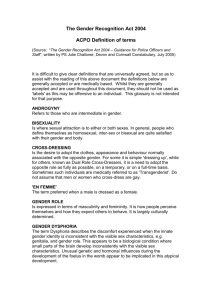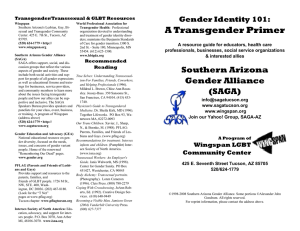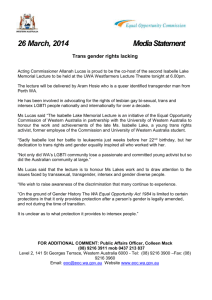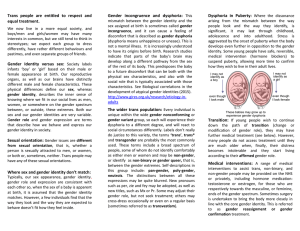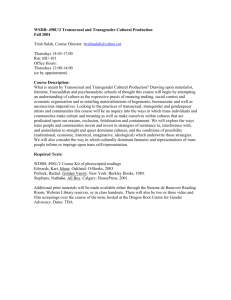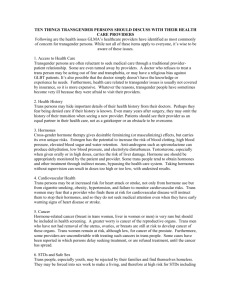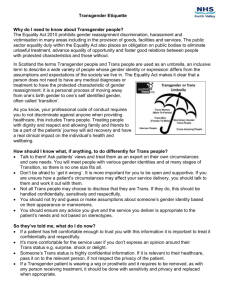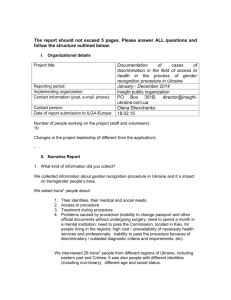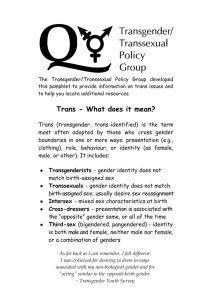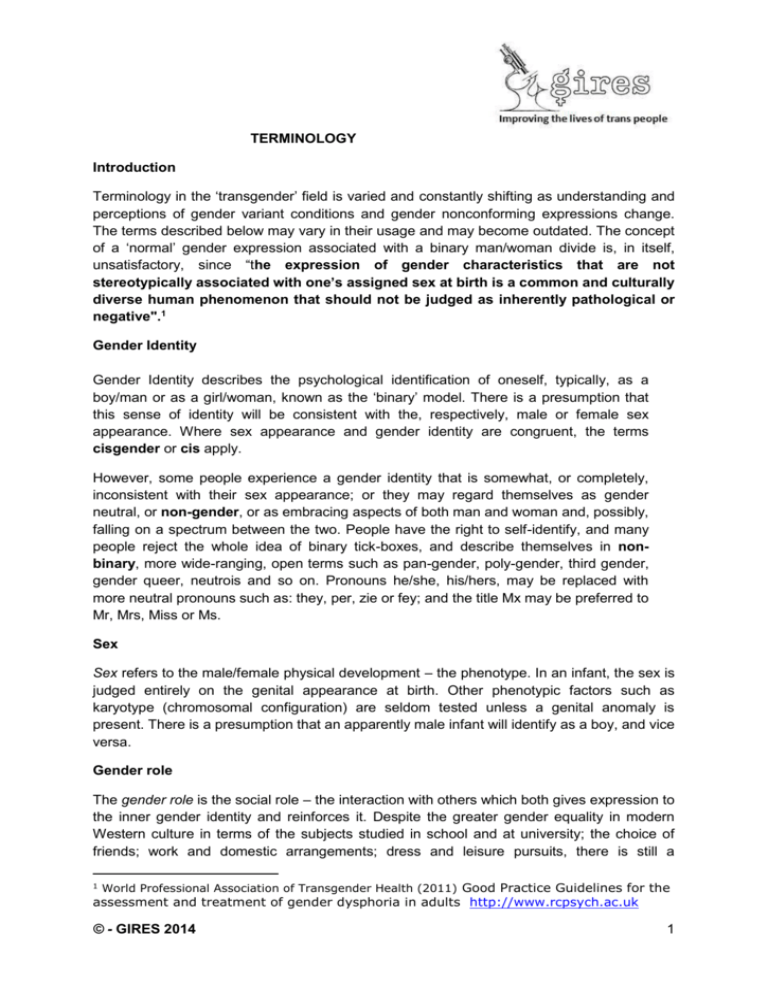
TERMINOLOGY
Introduction
Terminology in the ‘transgender’ field is varied and constantly shifting as understanding and
perceptions of gender variant conditions and gender nonconforming expressions change.
The terms described below may vary in their usage and may become outdated. The concept
of a ‘normal’ gender expression associated with a binary man/woman divide is, in itself,
unsatisfactory, since “the expression of gender characteristics that are not
stereotypically associated with one’s assigned sex at birth is a common and culturally
diverse human phenomenon that should not be judged as inherently pathological or
negative".1
Gender Identity
Gender Identity describes the psychological identification of oneself, typically, as a
boy/man or as a girl/woman, known as the ‘binary’ model. There is a presumption that
this sense of identity will be consistent with the, respectively, male or female sex
appearance. Where sex appearance and gender identity are congruent, the terms
cisgender or cis apply.
However, some people experience a gender identity that is somewhat, or completely,
inconsistent with their sex appearance; or they may regard themselves as gender
neutral, or non-gender, or as embracing aspects of both man and woman and, possibly,
falling on a spectrum between the two. People have the right to self-identify, and many
people reject the whole idea of binary tick-boxes, and describe themselves in nonbinary, more wide-ranging, open terms such as pan-gender, poly-gender, third gender,
gender queer, neutrois and so on. Pronouns he/she, his/hers, may be replaced with
more neutral pronouns such as: they, per, zie or fey; and the title Mx may be preferred to
Mr, Mrs, Miss or Ms.
Sex
Sex refers to the male/female physical development – the phenotype. In an infant, the sex is
judged entirely on the genital appearance at birth. Other phenotypic factors such as
karyotype (chromosomal configuration) are seldom tested unless a genital anomaly is
present. There is a presumption that an apparently male infant will identify as a boy, and vice
versa.
Gender role
The gender role is the social role – the interaction with others which both gives expression to
the inner gender identity and reinforces it. Despite the greater gender equality in modern
Western culture in terms of the subjects studied in school and at university; the choice of
friends; work and domestic arrangements; dress and leisure pursuits, there is still a
World Professional Association of Transgender Health (2011) Good Practice Guidelines for the
assessment and treatment of gender dysphoria in adults http://www.rcpsych.ac.uk
1
© - GIRES 2014
1
presumption of conformity with society’s ‘rules’ about what is appropriate for a man or a
woman, a boy or a girl, especially in terms of appearance. A significant departure from
stereotypical gender expression often causes anxiety and discomfort in those who witness it.
Their own discomfort may be reflected back on gender nonconforming individuals, causing a
continuous source of stress in social situations.
Gender variance/ gender nonconformity/ gender dysphoria
It is now understood that gender identity, although powerfully influenced by the sex of the
genitalia and the gender of rearing, is not determined by these factors. There is evidence
that sex differentiation of the brain is inconsistent with other sex characteristics, resulting in
individuals having a predisposition to develop a gender identity that is not typically
associated with the assigned sex. They may dress and/or behave in ways that are perceived
by others as being outside typical cultural gender expressions; these gender expressions
may be described as gender variance or gender nonconformity. Where conforming to
society’s cultural expectations causes a persistent personal discomfort, this may be
described as gender dysphoria. In many, this includes some level of disgust with the sex
characteristics, since these contradict the inner sense of gender identity. As mentioned
above, gender dysphoria stems also, in large part, from the stress associated with the
reactions of others towards people who express their gender differently.
Transsexualism
The terms ‘transsexualism’ and ‘transsexual’ are now considered old fashioned, and are only
likely to be seen in legal and medical documents. Even there, these terms are gradually
being replaced with more acceptable terminology, such as ‘transgender’ and ‘trans’ (see
below). In law, a transsexual person is someone who ‘proposes to undergo, is undergoing or
has undergone gender reassignment’ (Equality Act 2010). For some, this will involve
medical intervention to adjust the appearance so that it aligns with the gender identity, and is
often associated with changes to the gender role and expression, as well as names and
pronouns. These changes may alleviate much or all of the discomfort. The term transsexual
is specific, and does not include non-binary identities. The word ‘transsexual’ should be used
as an adjective, not a noun. It is, therefore, never appropriate to refer to an individual as ‘a
transsexual’, or to transsexual people, as ‘transsexuals’. The abbreviation ‘tranny’ is also
unacceptable.
Transgender
‘Transgender’ has had different meanings over time, and in different societies. Currently, it is
used as an inclusive term describing all those whose gender expression falls outside the
typical gender norms. It is often the preferred term for those who change their role
permanently, as well as others who, for example, cross-dress intermittently for a variety of
reasons including erotic factors (also referred to as transvestism). Those who live
continuously outside gender norms, sometimes with, and sometimes without, medical
intervention are covered by this term. There is a growing acknowledgement that although
there is a great deal of difference between say, drag artists and people who change their
role permanently, there are nonetheless areas in the transgender field where the distinctions
© - GIRES 2014
2
are more blurred; for example, someone who cross-dresses intermittently for some years,
may later change fully to the opposite gender role. Non-binary gender identities also fall
under this umbrella term.
Trans men and trans women
The expression ‘trans’ is often used synonymously with ‘transgender’ in its broadest sense.
Recently the asterisk has become an additional symbol of inclusion of any kind of trans and
non-binary gender presentation – hence trans* person.
‘Trans men’ are those born with female appearance but identifying as men; and those born
with male appearance but identifying as women may be referred to as ‘trans women’. The
terms may also be used to imply a direction of travel, towards a more masculine or feminine
gender expression, rather than a complete transformation of a person’s gender status. Many
trans people, having transitioned permanently, prefer to be regarded as ordinary men and
women. In these cases, where it becomes essential to refer to their pre-transition status, the
phrase ‘woman (or man) of trans history’ may be used.
Transition
Transition is the term used to describe the permanent adaptation of the gender role in all
spheres of life: in the family, at work, in leisure pursuits and in society generally. A few
people make this change overnight, but many do so gradually over a period of time,
changing their presentation intermittently, and sometimes whilst undergoing early medical
interventions such as hormone therapy. Transition does not indicate a change of gender
identity. The person still has the same identity post transition; the changes are to their
gender role, gender expression and sometimes their sex characteristics, to bring these in
line with their identity. A period of 12 months living full-time in the gender role that is
congruent with the gender identity is currently required before genital surgery is undertaken.
Transition in non-binary individuals is more likely to be a shift in gender presentation, rather
than a complete change of role; it may or may not include medical intervention.
Affirmed Gender
The gender identity does not change when a person transitions; the gender role and
appearance come into alignment with it. The term ‘affirmed’ gender, is now becoming more
common in describing the post-transition gender status. ‘Affirmed’ should be used in
preference to ‘acquired’; the latter is the language of the Gender Recognition Act, and is
more appropriately used to describe the acquisition of a Gender Recognition Certificate and
new Birth Certificate (see below).
Gender confirmation treatment
Those undergoing transition permanently usually have gender confirmation treatment that
includes hormone therapy and often surgery to bring the secondary sex characteristics:
breasts and genitalia, more in line with the gender identity. Such surgery is sometimes
referred to as gender (or sex) reassignment surgery. The term ‘sex change’ is not
© - GIRES 2014
3
considered appropriate or polite. Surgeries such as facial feminising and body contouring
may be chosen, but these are usually not provided on the NHS.
Intersex conditions
There are a number of intersex conditions (renamed Disorders of Sex Development – a
clinical description which many in the UK refuse to adopt). In some intersex conditions, the
appearance at birth is atypical being neither clearly male nor female. The sex (male or
female) assigned, and the anticipated gender role (boy or girl) assumed at that time, may not
be consistent with the core gender identity and may, therefore, result in a need to change
the gender role at a later stage. In addition, some of these individuals may have had surgery
neo-natally to create (usually) a female appearance. An individual raised as a girl, following
such surgery is at risk of identifying as a boy whose phallus has been removed. This occurs
in many individuals treated in this way. Surgical intervention before the individual is able to
give informed consent is now regarded, by many, as unethical.
Inconsistencies in development may be associated with atypical sex chromosomes such as
Klinefelter syndrome (XXY), Jacob’s syndrome (XYY), or atypical combinations of ‘X’ and ‘Y’,
such as XXYYY, XYYY and so on, including mosaicism (more than one chromosomal
configuration in the same individual). Genetic anomalies that are particularly associated with
unusual genital appearance are: Androgen Insensitivity Syndrome, Congenital Adrenal
Hyperplasia, 5α reductase or 17β Hydroxysteroid Dehydrogenase (HSD) deficiencies. Most
of these conditions, are associated with unusual pre-natal hormone levels. Other conditions
such as Cloacal Extrophy may be included in this group since babies with this condition may
have poor genital development, leading to male (XY) babies being surgically assigned as
girls.
Sexual orientation
Sexual orientation is a separate issue from gender identity. Sexual orientation is associated
with the sexual attraction between one person and another. This is quite different from the
internal knowledge of one’s own identity. Trans people may be gay, straight, bisexual or,
occasionally, asexual. Their sexual relationships may remain the same through the transition
process or, occasionally they may shift. So a person who is living as a man, and is in a
heterosexual relationship with a woman may, having transitioned to live as a woman,
continue to be attracted to women and seek a relationship with a woman – or – may be
attracted to men, and therefore seek a relationship with a man. Sometimes trans people
make lasting relationships with other trans people, so the possibilities are many and varied,
and do not necessarily fit comfortably into typical categorisations of sexual behaviours.
Those who remain in a long-term relationship, despite one partner having transitioned
cannot be categorised by any existing terminology, since the sexual orientation of the nontrans partner does not change; the orientation of the trans partner may or may not shift, as
described above. Sometimes, for clarity the terms: androphylic (attracted to men); and
gynaephylic (attracted to women) may be used.
© - GIRES 2014
4
Gender Recognition Certificate
In 2004 the Gender Recognition Act was passed, and it became effective in 2005. Those
people who have undergone a permanent change of gender status may endorse their new
gender status by obtaining legal recognition in the form of a Gender Recognition Certificate
(GRC). Applicants must provide paper evidence to the Gender Recognition Panel indicating
that they have already changed their name, title and gender role, on a continuous basis, for
at least two years; there is an expectation that they intend to live in the altered gender role
for the rest of their lives. A medical opinion indicating that the applicant has experienced
gender dysphoria is necessary. However, no medical treatment is required. Successful
applicants acquire the new gender status ‘for all purposes’, entitling them to a new birth
certificate registered under the changed name and title, provided that the birth was
registered in the UK.
The GRC has strict privacy provisions which must not be breached by any person acquiring
such information, in an ‘official capacity’. Disclosure to a third party could be a criminal
offence (GRA s22) (some limited exceptions apply)
The Marriage (Same-Sex Couples) Act, 2013, allows trans people to obtain a GRC within
a pre-existing marriage, which will then be converted to a ‘same-sex’ marriage, with the
consent of the non-trans spouse. When a trans person obtains a GRC within a pre-existing
Civil Partnership, that partnership must be changed into a marriage, with the consent of the
non-trans partner.
© - GIRES 2014
5

